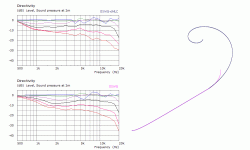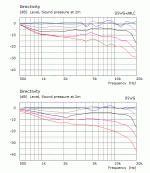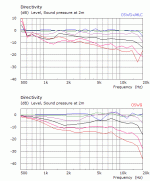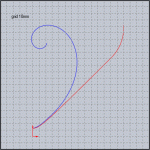I have some thoughts about lip rollback. The more beaming or well controlled directivity, the smaller rollback necessary.
That's why, I think, Earl sees minimum differences in lip roundout profile- the directionality has already been achieved in the passband, and the lip is only addressing things below the XO freq.
I beg to differ. It is reasonable and possible to fit a radius such that there is no discontinuity in surface curvature.
Yes, it is possible, but not with a constant radius flare of reasonable size. The curvature of the OS profile anywhere but close to the throat is rapidly approaching zero, or infinite radius of curvature. Patching a flare of constant radius and retaining reasonable overall diameter would necessarily cause a jump in curvature. That is why I asked about elliptic flares, log spirals and such.
Patching a flare of constant radius and retaining reasonable overall diameter would necessarily cause a jump in curvature.
Yes, of course, the angle of the walls and that of the baffle are different. There is always going to be a change in slope and there will always be diffracation. The more gradual this change in slope the less diffraction that occurs. Its not complicated, but its change in slope that matters (curvature), not change in curvature.
Hello Soongsc,
An important element to consider is that the curved mouth must provide minimum backreflected energy.
It as been shown by Bjorn Kolbrek using BEM that a Le Cléac'h horn has very low reflected coefficient from and above a frequency 1,4 times the acoustical cut-off.
So from this point of view the Le Cléac'h horn seems to be a good candidate as to be used at the mouth of any waveguide.
Best regards from Paris, France
Jean-Michel Le Cléac'h
An important element to consider is that the curved mouth must provide minimum backreflected energy.
It as been shown by Bjorn Kolbrek using BEM that a Le Cléac'h horn has very low reflected coefficient from and above a frequency 1,4 times the acoustical cut-off.
So from this point of view the Le Cléac'h horn seems to be a good candidate as to be used at the mouth of any waveguide.
Best regards from Paris, France
Jean-Michel Le Cléac'h
I have some thoughts about lip rollback. The more beaming or well controlled directivity, the smaller rollback necessary.
Last edited:
Hello Soongsc,
An important element to consider is that the curved mouth must provide minimum backreflected energy.
It as been shown by Bjorn Kolbrek using BEM that a Le Cléac'h horn has very low reflected coefficient from and above a frequency 1,4 times the acoustical cut-off.
So from this point of view the Le Cléac'h horn seems to be a good candidate as the mouth of any waveguide.
Best regards from Paris, France
Jean-Michel Le Cléac'h
But, sooooo big! The mouth flare contributes a very significant portion of the size of the horn in terms of baffle space. The critical diffractive component doesn't need to be dealt with geometrically. It can be managed with absorbtion. I tested some open-cell packing foam as a liner for the "Econowave" JBL PT "waveguides" (horns).

You can see that there's a bevel approximating a horn extension. This significantly reduced ripple (2dB or so) around the bottom end, where loading's falling apart. This is more than would be expected from an extension of similar scale, but without the benefit of reinforcing loading at those frequencies.
Nonetheless, once you've got sufficient horn for the passband, controls below the passband, and diffraction, don't necessarily need to be done with a 'normal' horn contour in a solid material. Absorbtion can achieve our goals very nicely.
FWIW, the combined reticulated foam (which extends to the phase plug) and foam mouth surround have completely eliminated all harshness from this horn. You'd never know it as a "horn" except by its positive characteristics, such as the ability to play ludicrously loud.
Hello Badman,
That horn on your picture is simply ugly! (it's just my opinion though...) [an it seems not very small either]
Best regards from Paris, France
Jean-Michel Le Cléac'h
That horn on your picture is simply ugly! (it's just my opinion though...) [an it seems not very small either]
Best regards from Paris, France
Jean-Michel Le Cléac'h
... You can see that there's a bevel approximating a horn extension.
Last edited:
Hello Soongsc,
An important element to consider is that the curved mouth must provide minimum backreflected energy.
It as been shown by Bjorn Kolbrek using BEM that a Le Cléac'h horn has very low reflected coefficient from and above a frequency 1,4 times the acoustical cut-off.
So from this point of view the Le Cléac'h horn seems to be a good candidate as to be used at the mouth of any waveguide.
Best regards from Paris, France
Jean-Michel Le Cléac'h
You mean the Le Cléac'h mouth? since the horn part is identical to an exponential, its only the mouth that differs. Any mouth curvature is going to surpress the mouth reflection, but a baffled waveguide will reflect less than an unbaffled one since the spatial discontinuity is 2 Pi instead of 4 Pi. Further, I submit that a radius is as good a mouth flare as any and all this discussion of sprials and Le Cléac'h is unimportant. None of it is supported with any data anyways.
Hello Badman,
That horn on your picture is simply ugly! (it's just my opinion though...) [an it seems not very small either]
Best regards from Paris, France
Jean-Michel Le Cléac'h
Hi Jean-Michel:
Yeah, it's ugly all right. We don't all do finished pieces when we're prototyping/testing. The foam is definitely very ugly though, it would want grille cloth. None of that changes the efficacy of the mouth treatment however. The size isn't too bad, the foam projects forward but not very far to the sides or top/bottom.
The yellow reticulated foam is better centered and no longer has the blue tape (you can see if you look) holding it in place. It's also masked by the shadows in the horn, that the flash on the cam illuminates.
But yeah, again, it's very ugly.
Last edited:
Hello Earl,
There is not something like a Le Cléac'h mouth attached at the end of an exponential horn. The Le Cléac'h profile is calculated from the throat to the mouth all along with the same expansion law...
In place of Le Cléac'h horn if you refute that name introduced first by David McBean and Bjorn Kolbrek (not by me) you can replace, if you want, that expression by the following one :"a horn belonging to the hyperbolic horns family calculated by the method developped by Jean-Michel Le Cléac'h"
BTW simulations demonstrates that any mouth curvature is not similarly efficient to the Le Cléac'h profile in reducing the reflection at mouth.
Best regards from Paris, France
Jean-Michel Le Cléac'h
There is not something like a Le Cléac'h mouth attached at the end of an exponential horn. The Le Cléac'h profile is calculated from the throat to the mouth all along with the same expansion law...
In place of Le Cléac'h horn if you refute that name introduced first by David McBean and Bjorn Kolbrek (not by me) you can replace, if you want, that expression by the following one :"a horn belonging to the hyperbolic horns family calculated by the method developped by Jean-Michel Le Cléac'h"
BTW simulations demonstrates that any mouth curvature is not similarly efficient to the Le Cléac'h profile in reducing the reflection at mouth.
Best regards from Paris, France
Jean-Michel Le Cléac'h
Any mouth curvature is going to surpress the mouth reflection...
Further, I submit that a radius is as good a mouth flare as any and all this discussion of sprials and Le Cléac'h is unimportant. None of it is supported with any data anyways.
Last edited:
Hello Earl,
There is not something like a Le Cléac'h mouth attached at the end of an exponential horn. The Le Cléac'h profile is calculated from the throat to the mouth all along with the same expansion law...
In place of Le Cléac'h horn if you refute that name introduced first by David McBean and Bjorn Kolbrek (not by me) you can replace, if you want, that expression by the following one :"a horn belonging to the hyperbolic horns family calculated by the method developped by Jean-Michel Le Cléac'h"
BTW simulations demonstrates that any mouth curvature is not similarly efficient to the Le Cléac'h profile in reducing the reflection at mouth.
Best regards from Paris,
Jean-Michel Le Cléac'h
Of course you realize that for small values a hyperbolic is an exponential. They are the same thing. They only difer at larger values of distance.
Please reference those simulations and what the criteria was for your claim to superiority.
Thats a classic example of a bad comparison. Why doesn't the OSWG take up as much space as the other one? Put a larger radius on a larger waveguide such that they are both the same size (length and diameter) and then do the comparison. Size is always an advantage and its not fair to compare to devices that are different sizes.
From my own experience, AxiDriver does not simulate free standing horn/guides very well. The directivity of baffled response is much closer to free standing measurements as I have shown previously in this thread.Comparison between pure OSWG and OSWG+JMLC hybride.
Thanks for clarification. I simulate OSWG in an infinite baffle and JMLC in a finite baffle. It is very easy to correct diffraction in OSWG with JMLC profile. Exchanging the lips isn't sufficient.
But the directivity control isn't nearly as good.
Hello Jean-Michel,Hello Soongsc,
An important element to consider is that the curved mouth must provide minimum backreflected energy.
It as been shown by Bjorn Kolbrek using BEM that a Le Cléac'h horn has very low reflected coefficient from and above a frequency 1,4 times the acoustical cut-off.
So from this point of view the Le Cléac'h horn seems to be a good candidate as to be used at the mouth of any waveguide.
Best regards from Paris, France
Jean-Michel Le Cléac'h
What you say is true. However, we must not forget that the energy of backreflection is proportional to the radiated energy around the lip. As I show here, an OSWG with the kind of lip I explained before produces less energy radiated on the sides, thus the backreflection is also reduced.
http://www.diyaudio.com/forums/multi-way/103872-geddes-waveguides-404.html#post2101785
If we consider the Le Cléac'h expansion using similar dimensions, the side energy might be much higher, and thus the lip rollback might be more critical. So whether lip rollback is critical or not depends on the actual design.
Last edited:
- Home
- Loudspeakers
- Multi-Way
- Geddes on Waveguides



